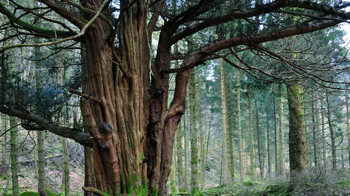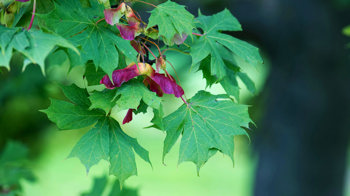
Coed y Gopa
Abergele

Woodland Trust wood
46.93 ha (115.96 acres)
SH937767
Explorer 264
OS Landranger 116
Located on a prominent limestone hillside in the Vale of Clwyd in North Wales, Coed y Gopa – combining the Welsh words for ‘wood’ and ‘summit’ – certainly lives up to its name. It is made up of two wooded hills – Coed y Gopa and a smaller wood known as Coed Bryngwenallt – divided by a public bridleway. This popular site offers visitors an abundance of wildlife, stunning flora, breathtaking coastal views and a wealth of historical features.
Features
- Parking at site
- Public access
- Autumn colour
- Waymarked walk
- Grassland
How to get to Coed y Gopa
Coed y Gopa is set on a prominent limestone hill overlooking the town of Abergele in the Vale of Clwyd in North Wales.
From the east: leave the A55 at junction 24 and follow the A547 through Abergele. Turn left onto Tan y Gopa Road and follow signs to the golf course. After reaching the golf course, bear right past the Conwy depot. The main entrance to the wood is on your left after almost three hundred metres.
From the west: leave the A55 at junction 23 and follow the A547 toward Abergele, passing the Gwyrch estate on your right. Turn right onto Tan y Gopa Road and follow signs to the golf course. After the golf course, bear right past the Conwy depot. The main entrance to the wood is on your left after around 300 metres.
The nearest train station is Abergele and Pensarn, 3.5km (just over 2 miles) from the wood.
Visit National Rail for more information.
The nearest bus top is on the A547, close to the junction with Tan y Gopa Road. There is then a 0.8km (0.5-mile) walk to the site, some of which is without pavements.
Visit Traveline for more information.
Facilities and access
There are eight pedestrian access points into Coed y Gopa and Coed Bryngwenallt.
The main entrance to the north-west, off the Rhyd y Foel road, has an entrance suitable for pushchairs and manual wheelchairs. The forest track from this entrance extends the full length of the wood, rising gradually to the top of the hill. This track is stoned but is rather bumpy, particularly the southern half. A network of narrower paths links to this main track. These are not surfaced, can be uneven in places, and where limestone bedrock is close to the surface they can be slippery when wet. In the vicinity of the Ffos y Bleiddiaid there is a footbridge and a set of steps.
The entrance at the north-eastern tip of the wood has no barrier but leads to a long flight of steps up a steep hill.
An entrance off Tan y Gopa road has a squeeze stile from which a path zigzags up a slope to join a track.
Coed Bryngwenallt is bisected by a public footpath, accessible from Tan y Gopa road (open gateway) or from adjacent fields (stile). A bridleway runs between the two sections of the wood.
There is a small car park at the main entrance to the wood, with space for around six cars.
The nearest public toilets are on Water Street in Abergele town centre. The disabled facilities require a RADAR key.
Wildlife and habitats
Animals
With a diverse combination of habitats, Coed y Gopa is home to a varied mix of rare and intriguing species, and is protected as a Site of Special Scientific Interest (SSSI). Rare lesser horseshoe bats make use of the several old mine workings across the site as hibernation roosts.
Birdlife is also plentiful in the wood, from the osprey to the goshawk. Spring and summer are excellent times to see and hear birds such as the pied flycatcher, redstart and wood warbler, which is especially common in the western oak woods of Wales.
Trees, plants and fungi
Coed y Gopa is brimming with flora. The northern part is ancient woodland, although large areas were replanted in the 1950s with beech, pine and larch, and natural regeneration has resulted in an abundance of self-sown broadleaf species. The southern part is similar, but its plantations also feature wild cherry, Norway maple and oak.
In areas of open canopy, sunlight filters through to a rich understorey of hazel, yew, and rowan. Here, the woodland floor is carpeted with dog's mercury, bramble and ferns. Visit in spring for seasonal displays of enchanter's nightshade, wood sage, honeysuckle and bluebell.
Habitats
Coed y Gopa is a rich and varied wood. The combination of predominantly broadleaved woodland, herb-rich grassland and wide rides that link these habitats provides homes for an abundance of invertebrates – creating ideal feeding areas for the bats.
Coed y Gopa was once part of the Gwrych Castle Estate and supplied the castle with fuel.
About Coed y Gopa
Coed y Gopa has a strong archaeological and mining heritage which you can see signs of on site.
Look out for the earthen ramparts of an Iron Age hillfort at the summit of the hill. The site is known as Castell Cawr, or 'Giant's Castle'. Ground surveys also found signs of roundhouses.
Mining
It is thought that mining began here in the Roman period, and that Abergele became an important trading post as Romans travelled along the North Wales coast.
The site was a hive of activity during the Middle Ages, when lead and copper were mined here. The remains of medieval mines can still be seen at the site today, including a deep, narrow cleft known as Ffos y Bleiddiaid, meaning Ditch of the Wolves.
Things to do at Coed y Gopa
Walking
With so much rare wildlife to see and fascinating history to uncover, it’s well worth embarking on a walk around Coed y Gopa. There is a waymarked trail to follow which allows you to discover more about both the site’s past as well as the wildlife here. So grab your walking boots and explore!


























































